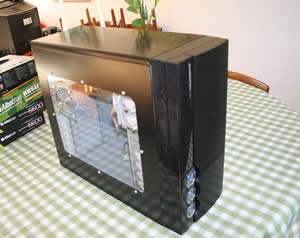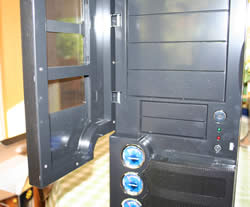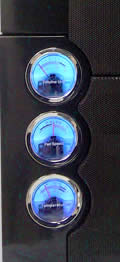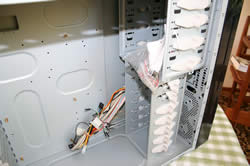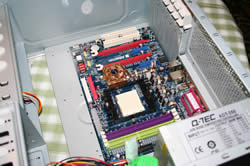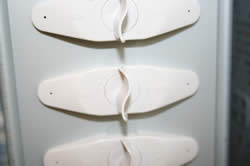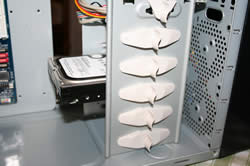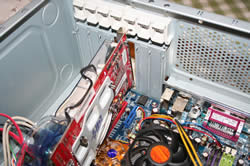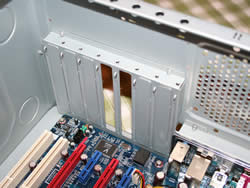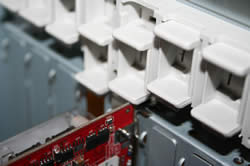The SunBeam Trio case has one visible cool feature; the three glowing analogue meters in the front of the case. We’ve tested it to see if this is all that the case has to offer or if there is more cool features lurking beneath the surface.
INTRODUCTION
Can you remember the days when the typical computer case was grey or beige? I’m not sure who decided to use those colours but you couldn’t call computer cases good looking or cool. Those days are now long gone and these days we expect our to be able to keep our cases out in the open without being ashamed of the look.
SunBeam sent over a new case from them, the SunBeam Trio, which both has a low cost but also look pretty cool.
PACKING UP THE CASE
The case comes in an ordinary box and is well protected. When you open up the package you find the case, some extra screws and a tiny A4 paper, which I guess is supposed to be a manual.
The first impression is pretty positive. I got the black version but you can also get it in silver or a black/silver version.
The case is made out of thin steel and moderately heavy. The front is made of plastic and the top half opens up to show the drivebays.
The most striking feature is the three analogue meters, which allows you to monitor sound pressure, fan speed and temperature. With their blue background the look really cool on the black case.
The case has four 5.25” spaces as well as two 3.5” space. Inside you also can add up to 5 harddrives. All the drives can be fastened using a tool-less system.
On the cooling side the case has a space for one 120mm fan in the front, two 80mm fans or one 120 mm fan in the back and a space for a 80 mm fan on the case window. No fan is however included so you have to buy those separately. While I understand Sunbeam want to keep the cost down it still feels a bit cheap considering other case-makers manage to include fans at a similar price. Still, the fans they used in the Transformer case were extremely loud so I guess it is just as well you have to buy your own anyway.
On the bottom right side you’ll find 2 USB 2.0 connectors, 1 firewire connector and the audio out/microphone connector. There are also two sliders there, which allow you to change the volume and the fan speed. I personally would have liked all these connectors at the top instead since I always keep my machines on the floor.
INSTALLATION
I mentioned an A4-sheet above which I called a manual but to be honest it is really worthless since it basically only show a picture of the 3 analogue meters. There’s no explanation at all on how to connect the cables inside, how to install the PCI cards (I’ll get to that in a second), how to install a 120mm fan and so on. In comparison Antec and Thermaltake include excellent manuals with their cases (at least the ones I’ve bought). SunBeam at least has instructions on their site on how to add a PCI-card and how to install a 120mm fan in the front.
Overall setting this case up still is relatively easy. It isn’t a huge case but a normal sized motherboard fits well. I installed an Albatron nForce Sli motherboard and there was a lot of space free around it. A larger motherboard however looks to come pretty close to the harddrive drivebays.
All the drives are attached using a tool-less solution. It does look a bit flimsy but works pretty well. The downside of this design is that to add or remove a drive you need to take away the sides of the case on both sides.
SunBeam also has added a tool-less solution for the PCI-slots although I’m not really sure you could call it tool-less since you still need a screwdriver to add/remove a card. It took some time for me to realize that to be able to insert anything I had to remove 3 screws, take away the plastic, add the card and put back the plastic again.
Unfortunately there still is a problem to get some graphics cards to fit in at the end. The image below shows what I mean. I still had to screw the card to the case.
Hooking up the case to the motherboard is reasonably easy. The cables are marked up. The case only has a 3-pin power-led connector which didn’t fit into the 2-pin connection on my motherboard but that’s something I can live with. Both the USB and Audio cables are split which means you have to make sure to put each pin on the right place. That’s why a manual is much needed.
USING THE CASE
Since I didn’t add any extra fans the noise level is dependant on the other fans in the system. In my case it meant a reasonably silent case. If you plan on adding more fans just make sure you get some silent ones.
The analogue meters glow up nicely in the dark but I must admit that in the end it’s more for show than any use.
CONCLUSION
The SunBeam Trio is a pretty nice case. The price isn’t too steep at around $70 but you don’t get any fans or any PSU with the case, which means the final price will be higher.
Pros
+ Looks good
+ Good quality feel
+ (Almost) no tools needed
Cons
– Some kind of manual would be nice
– No included fans
 Bjorn3D.com Bjorn3d.com – Satisfying Your Daily Tech Cravings Since 1996
Bjorn3D.com Bjorn3d.com – Satisfying Your Daily Tech Cravings Since 1996
